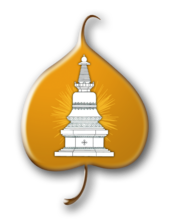
Everything on the altar is meant to help develop the mind in a positive way. There are three main symbols found on a Tibetan Buddhist altar:
- A stupa represents enlightened mind.
- Buddhist scriptures

for the Practice of Tibetan Buddhism in the Gelugpa Tradition

The center's altar is for our whole community. Anyone can offer flowers – anytime – to the altar and on sangha desks (vases are at the flower station outside under the pergola). During the winter we have less flowers growing at the center in Emily’s Garden, so community offerings are especially helpful.
Volunteers are an important part of creating a beautiful altar. There is a team who helps keep the altar clean and statues polished. They also set up special water bowl and extensive offerings for pujas and practices, which is a hands-on learning opportunity as well as a merit-making activity.
Making these offerings also creates the conditions for the center to flourish and for us to receive the teachings from Geshe-la and our many other wonderful teachers. The act of generosity also creates karma for you personally, which is the cause to have the wealth and resources you need in the future.
If you are interested in volunteering to help with the altar cleaning or setting up for pujas and practices, please contact our spiritual programs coordinator at program@kadampa-center.org.
Click below on objects on the altar to learn more about each.
 Everything on the altar is meant to help develop the mind in a positive way. There are three main symbols found on a Tibetan Buddhist altar:
|
 Chenrezig (Avalokiteshavara) is a bodhisattva of compassion. His Holiness the Dalai Lama is considered a manifestation of Chenrezig. |
 These shelves hold Tibetan Buddhist texts wrapped in protective cloth. They are shaped differently than Western books because the pages are long and stacked between two boards used as covers. On an |
 The Buddha of Loving Kindness, predicted to be the next buddha to appear in our world. |
 Like other statues, the Kalachakra statue represents enlightenment as well as specific states of the enlightened mind. |
 Making offerings is a way to counteract miserliness and cultivate generosity in the mind. |
 Shakyamuni Buddha is the historical Buddha born in the 6th century BCE in India, often referred to as just "the Buddha." Born a prince in the Shakya family, he later gave up his royal life to find |
 Kadampa Center is dedicated to the practice and study of Tibetan Buddhism in the Gelugpa tradition. |
 Just like a field is fertile ground for growing crops, the merit field of holy beings is the basis of accumulating merit, so are visualized when going for refuge, making offerings, and other prayers |
 His Holiness the 14th Dalai Lama Tenzin Gyatso is the spiritual leader of the Tibetan people and former head of state. |
 Rinpoche was born in Thami, Nepal, in 1946. At the age of three he was recognized as the reincarntion of the Lawudo Lama, who had lived nearby at Lawudo, within sight of Rinpoche's Thami home. |
 Green Tara is a female buddha of compassion closely linked to Avalokiteshvara (Chenrezig). She is known as an enlightened being ready to take action to benefit sentient beings, which is why she has |
 The throne symbolizes respect for the teachings of the Buddha, so when sangha members give teachings they traditionally sit on a throne like this one. |